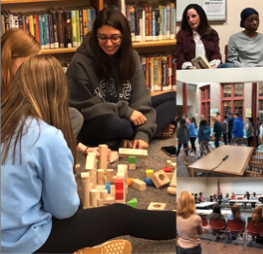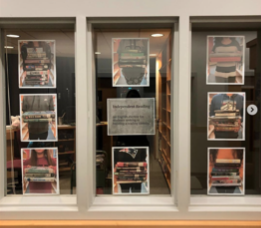I immediately emailed Christy Morley, a NAHS English teacher who had been increasing her students’ independent reading time. I enthusiastically supported Christy’s ideas to restructure her class time, providing students reading time in class and trips to the school library for book shopping. I had a feeling that Christy and I might be able to make an Independent Reading elective a reality at our school. She replied within the hour later that she wanted to have a meeting the following day.

While I asked Barbara Mahoney if we could borrow from and adapt her syllabus (she enthusiastically supported us) Christy picked the English Department Coordinator’s brain. She pointed out we already have English electives focused on writing, why not reading? She also added that an independent reading course would expand upon the Lucy Calkins reading North Andover students receive in elementary and middle school, but abruptly stops once students enter high school.
Endearingly, the coordinator also provided us with a dose of reality. What would we do when guidance placed a student in the class who does not enjoy reading? What if students registered for the class believing it would be a period of playtime? What about colleagues who might be skeptical of scheduling both an English teacher and the school librarian for the class? Thinking around these questions in our earliest rose-tinted brainstorming days grounded us, and helped us think through these obstacles, all of which we did face.
Christy and I sought input from district-level administrators prior to sharing our plan with the school leadership team. Our humanities coordinator and assistant superintendent both saw merit in what an independent reading course could bring to the high school, and both were excited for us to expand our partnership with the public library. The school leadership team was also supportive, all of our stakeholders supported the plan!
School librarians are often encouraged to build relationships with the public library, and our independent reading course would have been much different without support from the Stevens Memorial Library Director Kathleen Keenan. She was enthusiastic about sending her children’s librarian (the course was being developed while the SML worked to hire a teen librarian), Charlotte Arredondo, to NAHS multiple times to support our students. All IR students signed up for SML cards and Charlotte participated in First Read Friday (along with others from the North Andover community) and visited monthly to remotely circulate SML materials at NAHS.
We also had a field trip to Stevens Memorial Library. Christy met Newburyport author Meg Mitchell Moore, and conversationally shared what we were doing in North Andover, and Meg kindly offered support. This led to an October, 2019 walk to our beautiful public library where students had a pizza and salad lunch, sponsored by the Friends of the Stevens Memorial Library, and got to meet a published author who shared the role of reading in her personal and professional life.
Pandemic learning brought challenges to our 2020-2021 IR classes, including an Online Learning Academy (OLA) section taught synchronously with a hybrid section. This trimester I am teaching an additional OLA section with another English teacher who previously supported independent reading time in her classes. This has provided an opportunity for another English teacher to see the inner workings of the class and to understand how we have gone about helping students learn their reading identity and how to support them as readers. SML welcomed a teen librarian to its staff, Amy Fowler-Popoloski, in March, 2020 right before the world came to a halt. We have continued connecting every student with a public library card, and virtual collaborations, but we have not been able to bring the public library into our school library this year, or to visit them.
The shift to virtual learning environments has changed what our materials look like. Students now use digital reading identity notebooks, adapted from Laura Cahill’s model from Pernille Ripp’s work. Students now have detailed daily agendas and we have added more technology tools into our lessons. During periods of remote learning, or in our OLA sections, conferences have happened in virtual breakout rooms. NAHS joined the Commonwealth eBook Collection and has encouraged students to use the SML’s online offerings. I have delivered school library books to students’ homes. However, despite this school year’s challenges, we have been rewarded for our efforts by a student who told us she had never before seen herself in the books she read, a student who did not like reading who now loves graphic novels enough to have purchased some of his own, and multiple students who fit our initial course creation motivation. “I read all the time in middle school, but I just didn’t think I had the time any more. Now I’m reading again!”


